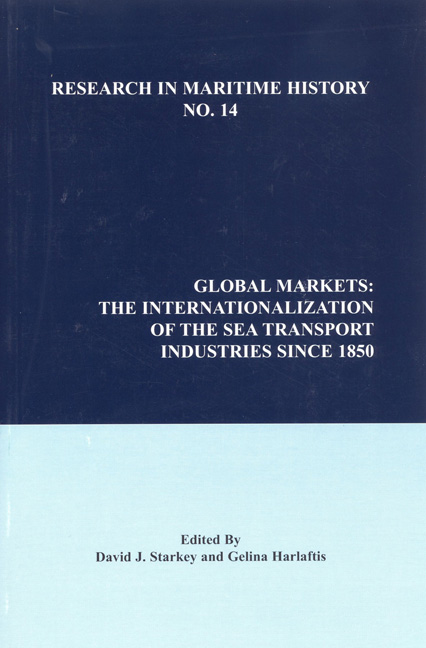Book contents
- Frontmatter
- Contents
- About the Editors
- Contributors
- Introduction
- “International Freight Markets in the 1830s and 1840s: The Experience of a Major Finnish Shipowner”
- “The First (and Very Secret) International Steamship Cartel, 1850-1856”
- “Competition or Co-operation in the Global Shipping Industry: The Origins and Impact of the Conference System for British Shipowners before 1914”
- “National Alliances and Global Webs: The Internationalization of Japanese Shipping”
- “Dutch Sea Transport in Transition: The German Hinterland as Catalyst, 1850-1914”
- “The Expansion of American Interests in Transatlantic Commerce and Trade, 1865-1893”
- “The Expansion of Japan's Shipping Interests before the Sino-Japanese War”
- “Cooperation and Reorganization on the North-South Routes from Japan in the Interwar Period”
- “The Global Communications Industry and Its Impact on International Shipping before 1914”
- “The Nineteenth-Century Roots of Globalization: Some Technological Considerations”
- “The Global Fish Market: Internationalization and Globalization, 1880-1997”
- “Convergence or National Styles? The Japanese Challenge to the British-Norwegian Hegemony in the Twentieth-Century Whaling Industry”
- “International Trends and Greek Shipping: The Business Strategy of Demetrios Moraitis, 1893-1908”
- “Organizational and Managerial Patterns of Greek- Owned Shipping Enterprises and the Internationalization Process from the Internar Period to 1990”
- “Internationalization and the Collapse of British Shipbuilding, 1945-1973”
- “Globalization and International Competitiveness: The Experience of the Japanese Shipping Industry since the 1960s”
- “Containerization and the Globalization of Liner Shipping“
“Dutch Sea Transport in Transition: The German Hinterland as Catalyst, 1850-1914”
- Frontmatter
- Contents
- About the Editors
- Contributors
- Introduction
- “International Freight Markets in the 1830s and 1840s: The Experience of a Major Finnish Shipowner”
- “The First (and Very Secret) International Steamship Cartel, 1850-1856”
- “Competition or Co-operation in the Global Shipping Industry: The Origins and Impact of the Conference System for British Shipowners before 1914”
- “National Alliances and Global Webs: The Internationalization of Japanese Shipping”
- “Dutch Sea Transport in Transition: The German Hinterland as Catalyst, 1850-1914”
- “The Expansion of American Interests in Transatlantic Commerce and Trade, 1865-1893”
- “The Expansion of Japan's Shipping Interests before the Sino-Japanese War”
- “Cooperation and Reorganization on the North-South Routes from Japan in the Interwar Period”
- “The Global Communications Industry and Its Impact on International Shipping before 1914”
- “The Nineteenth-Century Roots of Globalization: Some Technological Considerations”
- “The Global Fish Market: Internationalization and Globalization, 1880-1997”
- “Convergence or National Styles? The Japanese Challenge to the British-Norwegian Hegemony in the Twentieth-Century Whaling Industry”
- “International Trends and Greek Shipping: The Business Strategy of Demetrios Moraitis, 1893-1908”
- “Organizational and Managerial Patterns of Greek- Owned Shipping Enterprises and the Internationalization Process from the Internar Period to 1990”
- “Internationalization and the Collapse of British Shipbuilding, 1945-1973”
- “Globalization and International Competitiveness: The Experience of the Japanese Shipping Industry since the 1960s”
- “Containerization and the Globalization of Liner Shipping“
Summary
Although the country was not well endowed with raw materials, especially those with industrial value, it occupied a strategic position astride the estuaries of major rivers and was surrounded by the large and expanding markets of Britain, Germany and France. Being inconsequential on the economic map during the fourteenth and fifteenth centuries, the Dutch nation was on its way to attaining commercial as well as cultural preeminence by the sixteenth century. Early in their “golden” seventeenth century, forever remembered as an era of fabulous profits, the Dutch possessed about three-quarters of Europe's mercantile tonnage and conveyed an important part of the trade in the Mediterranean and the Baltic, thus transporting the imports and exports of many countries. The United East Indies Company, the famous VOC, almost succeeded in duplicating this success in Asia; that is, it eventually obtained a sizeable share in the inter-Asian trade.
However, during the eighteenth century, the complacent colonial power faced a steady decline as other European countries developed economically and started to build up their own maritime interests. The French occupation of the country in 1795 only aggravated the downward trend of prosperity and the structural decay of the Dutch economy. Yet on the eve of the First World War, the Netherlands was once more the home of one of Europe's leading economies, with a fully developed, “modern“ industrial sector. The climacteric in the economic fortunes of the Dutch occurred during the nineteenth century. This chapter explores the development of Dutch sea transport — comprising the three related branches of shipping, shipbuilding, and the port industry (chiefly Rotterdam) — to provide, inter alia, an insight into how and why the transformation took place.
The nineteenth century was an era of contrasts for the Netherlands. The newly unified (with Belgium) kingdom stumbled into it without much luck. For decades after the Napoleonic Wars, when West European countries such as France, Belgium, and Germany were following the British model of modern industrialization, former Golden Age pioneer Holland seemed unable to do the same and drifted further back into commercial nostalgia and economic stagnation. Only during the second half of the nineteenth century, did the Netherlands modernize, leading to a remarkable reversal of fortunes.
- Type
- Chapter
- Information
- Global MarketsThe Internationalization of The Sea Transport Industries Since 1850, pp. 103 - 126Publisher: Liverpool University PressPrint publication year: 1998



